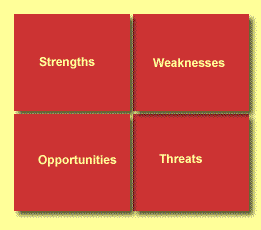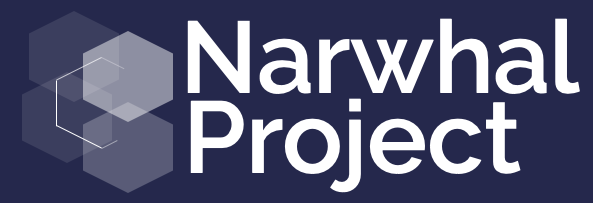by Charles Plant | Oct 2, 2012 | Exercises, Management
 Last week I looked at the topic of thinking strategically. One critical dimension of this talent is the ability to see Strengths, Weaknesses, Opportunities and Threats. SWOT. Most of us are good at recognizing strengths and perhaps next at seeing opportunities but we’re usually not very good at finding weaknesses and even worse at seeing threats. If you want to get better at critically examining SWOT in your own organization then you need to be asking yourself these questions:
Last week I looked at the topic of thinking strategically. One critical dimension of this talent is the ability to see Strengths, Weaknesses, Opportunities and Threats. SWOT. Most of us are good at recognizing strengths and perhaps next at seeing opportunities but we’re usually not very good at finding weaknesses and even worse at seeing threats. If you want to get better at critically examining SWOT in your own organization then you need to be asking yourself these questions:
Strengths
For some reason, companies always state that their strength is their people. That’s too easy an answer, a bit self-serving, and in fact it doesn’t really matter to the customer.
- What are customers really buying? Is it Quality, Cost or Speed?
- How are we better at delivering these things to customers than the competition?
Weaknesses
Many organizations don’t like to be self critical. It’s not a good feeling but you better get over the adolescent angst because if you can’t see your weaknesses, your customers can and your competitors will capitalize on them.
- How are our competitors delivering better quality, lower cost of faster service than we are?
- Where is there confusion, conflict, and missed results in our customers minds?
Opportunities
People love new ideas, seeing in them myriad opportunities for new products or services. Ideas are fun but are they real opportunities?
- How can we deliver something to customers that sets a new and vastly different standard in quality, cost, or speed of service?
- Can we disrupt a market or find an entirely new market by reducing quality and cost drastically or increasing both by big margins?
Threats
The threat for any company is that some competitor will come out of left field to dramatically change the existing paradigm.
- What are customers hidden needs that we aren’t meeting that someone else could capitalize on?
- How is the customer changing in ways that we aren’t addressing?
If you’re paying attention, you’ll notice that if you’re thinking strategically, all of these questions are about the customer, not about you. In the end, the only thing that matters in SWOT analysis is the customer.
by Charles Plant | Sep 21, 2012 | Exercises
One of Steve Job’s greatest strengths was knowing how to focus. When he came back to Apple in 1997 as a consultant, he found a company that was severely unfocussed. Apple had a dozen different versions of the Macintosh and each of the versions had a different confusing number ranging from 1400 to 9600. Even Jobs couldn’t figure out how to recommend which versions one of his friends should buy.
At one product session, Jobs had had enough and he grabbed a magic marker and drew a four square chart on a whiteboard. “Here’s what we need,” he stated. On top of the two columns he wrote Consumer and Pro. The two rows he labeled Desktop and Portable. Apples’ new focused job was to make four products, one in each quadrant. This ability to focus saved Apple from extinction.
“Deciding what NOT to do is as important as deciding what to do. That’s true for companies, and its true for products.” And it’s true for managers.

If you’re having trouble figuring what to focus on, then sit back and think. What are you doing that gives you the best bang for the buck in:
- delivering and improving quality,
- reducing cost, or
- saving time.
by Charles Plant | Sep 14, 2012 | Exercises
A Software Engineer, a Hardware Engineer and a Branch Manager were on their way to a meeting. They were driving down a steep mountain road when suddenly the brakes on their car failed. The car careened almost out of control down the road, bouncing off the crash barriers, until it miraculously ground to a halt scraping along the mountainside. The car’s occupants, shaken but unhurt, now had a problem: they were stuck halfway down a mountain in a car with no brakes. What were they to do?”
I know,” said the Branch Manager, “Let’s have a meeting, propose a Vision, formulate a Mission Statement, define some Goals, and by a process of Continuous Improvement find a solution to the Critical Problems, and we can be on our way.”
“No, no,” said the Hardware Engineer, “That will take far too long, and besides, that method has never worked before. I’ve got my Swiss Army knife with me, and in no time at all I can strip down the car’s braking system, isolate the fault, fix it, and we can be on our way.”
“Well,” said the Software Engineer, “Before we do anything, I think we should push the car back up the road and see if it happens again.” (Stolen from www.jokebuddha.com)
 More Ideas on Meetings
More Ideas on Meetings
I am constantly hearing people say that they got nothing done one day as they spent most of the day in meetings. Actually this is a problematic attitude. Meetings are for getting things done and in addition they are not exclusively for getting things done. A meeting has and should have a variety of purposes. They are not only about getting things done, they are about bonding, getting to know colleagues, sharing stories, having a good time and generally enjoying each others company. We are not meant to be solitary workers and meetings are a positive way of adding some enjoyment to the working day, as long as you actually enjoy the people you are meeting with. That being said, it is still possible to waste time in meetings.
There are all sorts of advisors who would tell you that it is critical to follow a certain set of steps in order to have a productive meeting. These would be to have a chairperson, set an agenda, record minutes and stick to the agenda. Having been in over 10,000 meetings in my working life I have to admit that the number of times that I have seen someone follow the proscribed method of having a meeting is less than a handful. These meetings are in fact among the worst I ever attended. People are not meant to work that way; they are more free flowing and extemporaneous than would be allowed for in a highly structured meeting.
The key to any meeting is simple. Just have an objective. That’s it, a simple objective. A meeting should be about either of two things: developing a plan or working on removing obstacles. Meetings that are just used to update people about the status of one thing or another are a waste of time. Updates are better handled through regular reports as to status and the recipient can spend as much time as is necessary to get as much of a picture is necessary when it is a regular report.
Before any meeting and at the beginning of the meeting you should establish the objective of the meeting. As the meeting progresses, let it meander over different territory from time to time but if it strays too far or for too long then gently remind people about the objective of the meeting. Going with the flow means that you don’t obsessively adhere to the objectives but every now and then make sure that you are making progress in meeting them. At the end of the meeting all you need to do is make sure that you met the objective and that there is a plan for follow up that is reinforced in an email by whoever owns the plan. Not too rigid or complex, just enough to be efficient
by Charles Plant | Sep 13, 2012 | Exercises
 I keep running into people who complain that they are in meetings all day and they don’t manage to get anything done. Even if you want to, you won’t be able to eliminate all meetings and you’ll even have a hard time reducing them. They will fill up your calendar whether they are a priority for you or not. In many cases they are a priority for someone else and not for you but for the sake of playing nicely in the sandbox you’ll need to accept them. You can save yourself this anguish by following a few rules:
I keep running into people who complain that they are in meetings all day and they don’t manage to get anything done. Even if you want to, you won’t be able to eliminate all meetings and you’ll even have a hard time reducing them. They will fill up your calendar whether they are a priority for you or not. In many cases they are a priority for someone else and not for you but for the sake of playing nicely in the sandbox you’ll need to accept them. You can save yourself this anguish by following a few rules:
- Never have a meeting the minute you get into the office in the morning. Make sure that you have at least half an hour before the first meeting to deal with email from the night before and to figure out your priorities for the day and a to-do list.
- Unless they are all of one type, try not to have meetings back to back. If you can, allow for an hour between all meetings, as this will be important time for dealing with email and coworker questions and keeping current on them. Also, meetings have a habit of going overtime and since it is rude to leave early and arrive late then you are better off with a buffer between them.
- Don’t let people book time in your calendar. Now, since most people have public calendars, all sorts of people will see that you have free time and try to schedule a meeting onto that time. Don’t let them do that. Just refuse those meetings. If you let them do that, you are letting them take control of your priorities and letting them control your working day.
- The next key is to never finish the working day with a meeting. If you do, you won’t be able to tidy up, deal with last minute things and plan for the next day.
- Finally, never book a meeting after 3:00 pm on a Friday. Having a few hours at the end of the week to wind down, clear out a few things that need to be done and plan for the next week is essential. Having no meetings at the end of the week will leave you feeling relaxed and in control.
By controlling when you have meetings you remove the risk that meetings will take over your calendar and you’ll have time to get other things done.
by Charles Plant | Sep 6, 2012 | Exercises
Oh, oh. This turned out to be a bit longer post than I wanted so please excuse the length. Since we’re on the topic of email this week, I thought it would be useful to explain how to managing email instead of letting it manage you. We all do this differently but this is what works for me.

The Objective
Your objective for managing email should be to have a virtually empty inbox. If you manage to achieve this you’ll be in control, organized, and responsive to those who are seeking your attention.
Get Organized
Before you start dealing with email you need to get organized. Just as you would have file drawers and file folders for every paper you touch, so must you have folders and files for each and every project you are working on. Organizing email by project means that it is easy to understand where an email would be filed and you can find it quickly without a search tool.
First In, First Out
The next thing you must organize is the order in which emails are presented. You should organize them, not with the most recent at the top but the most recent at the bottom. Organizing them at the top means that you can leave emails alone as they drop farther and farther down the window until they are out of site and forgotten. If the oldest ones are at the top it is saying that you have to deal with these first before you get to the newer ones. First in First out. Not Last in First Out. If you control the receipt to the bottom and have to deal with older ones first, filing them when you are finished in project oriented files then you will only have things in your inbox that you have not dealt with yet.
Process Email in Batches
If you look at email all day long then you’re letting it run your life. If you handle it only once a day you’ll get overwhelmed. The key to email is processing it in batches. The best way to do this is to make sure that you reserve time for email between formal meetings, handling those that just came in at the beginning of the day and then once every two hours or so for only a few minutes. If you do this, you’ll be managing email instead of letting it manage you.
Limit the Number of Touches
Now all the experts will tell you to handle email only once but that isn’t very realistic. I figure if you limit yourself to handling each email only twice then you’re doing well.
When you get back to your desk after a meeting then the first thing to do is to read all of the email that you received while you were out. That is handling it the first time. Looking at all of it at once allows you then to prioritize your email instead of doing it on a first in first out basis. While you might think that the next thing to do is to deal with the most important email first, this is exactly the wrong thing to do. What you need to do next is email management. Get rid of all the email that does not need more than a two word reply.
- Delete any junk email
- File any email that does not need a reply in the appropriate folder.
- File any emailed newsletters in a file to review on Friday afternoons or at lunch time. This is a file that can accumulate as it doesn’t really matter if you ever read these.
- Send replies or delegate quickly any things that can be handled by others.
If like most people, you are getting and sending an average of 110 emails a day, then about 10 or 20 of them will not fall into those categories. Dealing with the unimportant emails first in the manner specified above will take about five minutes every time you sit down to deal with email. If you have left an hour between meetings then you’ll have lots of time to deal with the two or three important emails you get that require some work or a longer response.
More Complex Emails
Now to the ones that require some work, the key is to think about them for a while. Don’t do them right away. Target though to get them dealt within 24 hours of their receipt. Giving yourself time to think about how to deal with them will mean that you handle them twice or even three times but that should give you time to figure out if they are material and how you can do the least amount of work possible and still meet the other person’s needs. When you are ready and only when you are totally ready ten deal with the mail and file it away. In this way you should be able to maintain an inbox that is relatively clean.
If you have something that you cannot deal with right away, send a response indicating when the person should expect a full response. If there is something that you need to follow up on then establish another folder for follow up items that you check once a day.
by Charles Plant | Aug 29, 2012 | Exercises, Leadership Development
Well? Do you have one? I ask many people this question and I get very few coherent answers. This vision stuff is hard. It’s easier to go with the flow but as Yogi Berra famously said, “If you don’t know where you are going, you will wind up somewhere else.” You weren’t expecting that quote were you. You were probably expecting something like: “If you come to a fork in the road, take it.” I also happen to like: “You’ve got to be very careful if you don’t know where you’re going, because you might not get there.”
Whatever. The thing is, if you don’t have a personal vision, then your life will be subject to those around you who do have personal visions. You’ll spend your life making their visions into reality instead of making one of your own.
If you don’t have one of your own and want to develop one then you could read “A Lazy Man’s Guide to Success.”

For a short cut to developing your own vision, you could answer the following questions that come from the book:
What is your Work? What happens when you are giving your greatest gift to the world? How are people different as a consequence of having been in your presence? See it as an image. Use present tense. Answer these questions:
- What gives you a sense of aliveness, that feels “just right”?
- What do you dream about; what holds you spellbound?
- What are blessings you could give back to the world?
- Whose work or life inspires you?
- What would you talk about if given an hour of prime time TV to influence the nation or the world?
- What makes you angry enough to correct in the world?
- What contribution of yours will be more profound than others doing something similar?
 Last week I looked at the topic of thinking strategically. One critical dimension of this talent is the ability to see Strengths, Weaknesses, Opportunities and Threats. SWOT. Most of us are good at recognizing strengths and perhaps next at seeing opportunities but we’re usually not very good at finding weaknesses and even worse at seeing threats. If you want to get better at critically examining SWOT in your own organization then you need to be asking yourself these questions:
Last week I looked at the topic of thinking strategically. One critical dimension of this talent is the ability to see Strengths, Weaknesses, Opportunities and Threats. SWOT. Most of us are good at recognizing strengths and perhaps next at seeing opportunities but we’re usually not very good at finding weaknesses and even worse at seeing threats. If you want to get better at critically examining SWOT in your own organization then you need to be asking yourself these questions:


